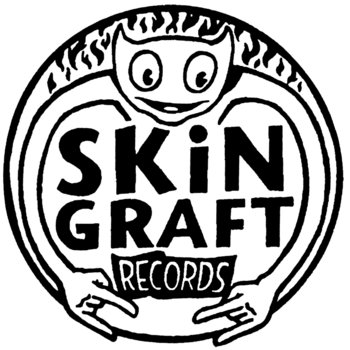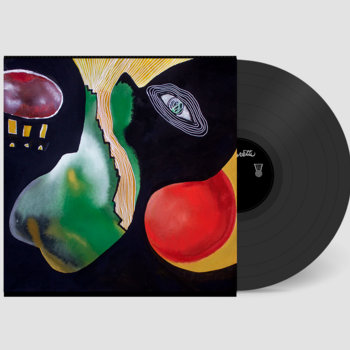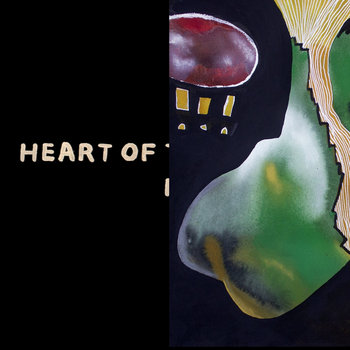 Photos by Doug Coombe and Ronna Foote
Photos by Doug Coombe and Ronna Foote
In 1992, grunge swept the music industry like a five-alarm fire, incinerating everything in its path. No one was safe, whether they were Michael Jackson or Guns N’ Roses or Color Me Badd. By the following year, the “Alternative Nation” was in full swing; radio sounded different and MTV looked different. While this was a sea change from the previous decade’s glut of ultra-polished commercial rock, for some it wasn’t a radical enough course correction. Enter Couch, a pair of natural born hellions who perfected a style of agitated noise rock within the leafy confines of Ann Arbor, Michigan.
James Magas was a rabid music fan who longed to be in a band, but found playing even straightforward punk rock beyond his reach. Then he discovered Japanese noise music, and the possibilities seemed endless. In a desperate attempt to ferret out like-minded weirdos with whom to start a band, Magas began terrorizing house parties by hijacking the CD player to spin discs by Boredoms and Violent Onsen Geisha. Word soon got around town. Walking home late one night, a pick-up truck ominously pulled up next to Magas and the driver shouted, “You the guy that wants to start a band?” The shouter was a guitar player named Pete Larson whose band had just broken up. As they bantered in the dark, clowning on local bands while sizing each other up, a plan came into shape. Magas blurted out, “Can we call it Couch?!” Not long after, Magas had a dream that Larson was performing under the name Mr. Velocity Hopkins; Magas took the moniker Marlon Magas and Couch lurched to life. Equally indebted to the electroshock convulsions of no wave and the serrated edge of the rawest garage punk, Couch came to define the Midwestern sub-underground: Gories meets Mars in a wood-paneled basement.




7" Vinyl


Backed by a succession of drummers, Magas and Larson performed in suits, usually to bewildered crowds, sweating it out in smokey dives like off-duty accountants on a weekend bender. Bound by their own idiosyncratic criteria, Couch gestured towards a purity of form. There were no drum fills, no effects pedals, no unnecessary adornments to distract from the frantic energy of the front line. With Larson lurching about, swinging his guitar like a broadsword, Magas battered his own six-string while manhandling the mic, completely freaking out the squares.
“I didn’t drink alcohol or take drugs, but I did drink a lot of coffee,” he says. “We viewed the audience with contempt. Every show felt like some kind of battle, both with the audience, and sometimes each other.”
Couch frequently opened for Laughing Hyenas, the ferocious Ann Arbor quartet whose lead singer John Brannon was one of their few vocal supporters. For the most part though, Michigan rock fans were not down with Couch’s in-your-face style. “People would threaten us,” Larson says. “One gig, someone threw broken glass at us.” But the scene had to revise its opinion when Couch, which seemed like a joke to some, released a 7-inch EP on their own label, Bulb. Though started by the duo, Larson took over operations as Bulb began documenting their corner of the underground, releasing records by local garage outcasts the Monarchs, along with Larson’s other band, Prehensile Monkeytailed Skink, and early Quintron project Math. As Larson puts it, “The label was another tool in our confrontational war chest. We figured live music wasn’t enough, there had to be records too.”
Because Larson spent the year working in Germany, 1994 was a fallow period for Couch. Magas kept busy with side hustle the Many Moods Of Marlon Magas, which spliced free jazz with his manic frontman persona. When Larson returned stateside, the pair reformed Couch with a new drummer, a teenager named Aaron Dilloway, who had seen Couch opening for the Hyenas at a basement show in the fall of ‘92. “Jim was suave and creepy. Pete was frantic and terrifying. This was exactly what I had been searching for,” Dilloway remembers. Incorporating the enthusiastic Dilloway into the group rejuvenated Couch, leading to a West Coast tour and the recording of another 7-inch. In 1995, Couch’s lone full-length, the unhinged Glass Brothers 1993-1994 CD, surfaced just as the band was fading out.
After Couch folded, Magas headed to Chicago, where a vital scene awaited. Spearheaded by noise punk/comic book purveyors Skin Graft and Weasel Walter from the Flying Luttenbachers, Chicago was in the throes of its Now Wave renaissance, a small but dedicated scene of art-damaged misfits who channeled no wave’s intensity and absurdity in equal measures. Magas and Walter put together Lake of Dracula, which featured Heather Melowic from Scissor Girls and Al Johnson, aka “The Manhattanite” of U.S. Maple. Recorded by Jim O’Rourke, Lake of Dracula’s self-titled album is the sound of the id run amok, dishing out hook-filled dada punk like some unholy combination of DNA and the Damned. After adding bassist Jessica Ruffins from the vicious Jaks, Lake of Dracula completed a tour and a few more recordings before the well dried up.



Compact Disc (CD)

Larson, meanwhile, was revving up 25 Suaves, his duo with drummer Fumie Kawasaki, which spent the early ‘00s releasing records and touring extensively. Larson was a one man David Lee Roth/Eddie Van Halen hybrid, slinging sick riffs and high leg kicks across the country. Bulb released a series of genre-defying albums by Incapacitants, King Brothers, Mindflayer, Wolf Eyes, and Andrew W.K., among others.
Following Lake of Dracula’s dissolution, Magas was done with the whole concept of “bands.” He questioned whether he could maintain a collaboration as intense as his two previous projects. He was briefly adrift before diving into the world of analogue electronic gear, first using a Roland Groovebox before graduating to Juno and ARP synthesizers back when they were still somewhat affordable in the early 2000s. Magas began playing shows with mutant techno eccentrics like Peaches and ADULT., who recorded and released Magas’ first couple records on their label Ersatz Audio. As his synth collection grew, Magas’ records reflected his evolving craft.


Larson had wound down Bulb in the mid ‘00s, and by 2015 he was residing in Nairobi, Kenya, soaking up the local culture. One day, he encountered a young boy playing an eight-stringed lyre called a nyatiti and was inspired to learn the instrument, studying under master Oduor Nyagweno. As he delved into the instrument’s rich history, Larson couldn’t help but consider starting another label to bring attention to the exhilarating music he was encountering on a daily basis. Despite the flood of African-based guitar music being released by Western labels, Larson knew he had a unique angle in his overlooked locale. Named after the part of town he lived in, Dagoretti Records became a signpost to a land where music was the essence of life, as elemental as the sky above and the ground below, but also humming with electricity. “European arts organizations were offering up samplers of traditional music with no nod to the vibrant modern culture. They take a museum-like approach, which I completely hate,” he says. “African music is just like American music—people make stuff to party to, and cry to; it isn’t this high-mannered thing that arts orgs present.”
Larson, who grew up in Mississippi, doesn’t see much difference between the blues he grew up with and the unadorned reality that nyatiti music offers: “It’s driving, four-on-the-floor beats with repetitive riffs and a guy singing vile sex stories over it. It taps into this language that all of us speak.” When it comes to the question of what to release on Dagoretti, the decisions aren’t always easy, especially with the compilations of hard-to-find 45s and 78s. “It is possible that I have the largest collection of nyatiti music in the world. All of it is great,” Larson says.




Vinyl LP


But not all of Dagoretti’s African releases focus on Kenya. For example, there is a cell phone-recorded album by Ghanaian singer Abusuzit Akugru and her band. Cell phone recordings act as a sort of musical currency in Africa. Larson has released several cassette collections of songs encompassing a range of different locations and musical forms that found their way into his hands, all sourced from cell phones.
In the late 2010s, after he made his way back to Michigan, Larson started his Cytotoxic Nyatiti Band, which numbers Fred Thomas from Tyvek and Tom Hohman from The USAisamonster among its ranks. Their output prioritizes the trance-inducing aspect of nyatiti music by welding it to a sturdy psych-rock framework.





Vinyl LP, Compact Disc (CD), T-Shirt/Apparel



Considering his former identity as the untamed Mr. Velocity Hopkins, it could be assumed that the “Dr.” in front of Larson’s name is a put-on, another layer of obfuscation by an artist known for perplexing the general public. But Larson does in fact possess a PhD, and works as a public health researcher tackling issues of climate change and how it impacts human health. Between this important research and his dedication to preserving and promoting East African music, a certain harmony coalesces around Larson’s activities. But unlike his work with Couch, Larson and Dagoretti aren’t bound by any stringent rules. In addition to dropping a series of lockdown tapes made by associates of the label during quarantine, Dagoretti has put out three releases by DC-based free jazz upstarts Heart of the Ghost, including a live album where the trio was joined by trumpeter Dave Ballou.





Vinyl LP, Compact Disc (CD)



After issuing a steady stream of electro-punk EPs and full-lengths in the 2000s, Magas worked on the score for Asia Argento’s 2014 film Misunderstood. Since then, Magas had been uncharacteristically quiet, but that all ended last year when he released Confusion Is My Name on his own Midwich Productions. Midwich was designed to present records by underground electronic peers like Dilloway’s Mick Travis alter ego and Moon Pool & Dead Band, a duo of David Shettler and Wolf Eyes’s Nate Young. For the initial ten releases, Mark Salwowski’s artwork established a distinctive visual palette that references the irradiated 1970s and ‘80s science fiction paperbacks and VHS tapes that these artists grew up on.
By the time Magas was ready to unleash Confusion upon the world, he had stepped back up to the microphone and enlisted a cavalcade of talented friends, including Argento, Quintron, and French producer Electronicat. The album cover treatment done by renowned illustrator Robert Beatty of Maria Tzeka’s photography lets Midwich devotees know they are in for something fresh and different. Showcasing his most straightforward songs yet, Magas doesn’t neglect his usual strangulated beats so much as condense them into diamond-sharp nuggets of pure attitude and abandon.



Vinyl LP

The music never stops for these two old friends. Now, it’s Larson’s turn to get bitten by the electronic bug. Inspired by ad-hoc performances he saw in Africa (“People over there don’t sit around and wait. They just make music with what they have,” he says) and, closer to home, Detroit’s legacy as the birthplace of techno, Larson has created yet another imprint, Great Corner Sound, which provides space for Larson’s modular synth practice along with sample-based work by Fred Thomas and Rebecca Goldberg.






Cassette, Vinyl LP




Never one to rest on his laurels, Larson is working on “techno tracks made entirely out of samples from my recent trip to Taiwan.”
James Magas echoes this unwavering commitment to exploration and reinvention with a Zen-like clarity: “Making music is its own reward.”







